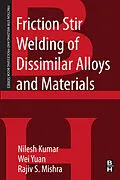This book will summarize research work carried out so far on dissimilar metallic material welding using friction stir welding (FSW). Joining of dissimilar alloys and materials are needed in many engineering systems and is considered quite challenging. Research in this area has shown significant benefit in terms of ease of processing, material mixing, and superior mechanical properties such as joint efficiencies. A summary of these results will be discussed along with potential guidelines for designers.
- Explains solid phase process and distortion of work piece
- Addresses dimensional stability and repeatability
- Addresses joint strength
- Covers metallurgical properties in the joint area
- Covers fine microstructure
- Introduces improved materials use (e.g., joining different thicknesses)
- Covers decreased fuel consumption in light weight aircraft
- Addresses automotive and ship applications
Autorentext
Nilesh. N. Kulkarni completed his M.E. (electronics and telecommunication) from All India Shri Shivaji Memorial Society's Institute of Information Technology, Pune. His areas of interests include biomedical signal and image processing, pattern recognition, and machine learning. Presently, he is working on biomedical signal processing applications. He is a member of IETE and IEI, India and a member of the IEEE.
Inhalt
Preface to This Volume of Friction Stir Welding and Processing Book Series
Chapter 1. Introduction
Chapter 2. A Framework for Friction Stir Welding of Dissimilar Alloys and Materials
Chapter 3. Tool Design for Friction Stir Welding of Dissimilar Alloys and Materials
Chapter 4. Friction Stir Welding of Dissimilar Alloys
Chapter 5. Friction Stir Welding of Dissimilar Materials
Chapter 6. Modeling and Simulation of Friction Stir Welding of Dissimilar Alloys and Materials
Chapter 7. Challenges and Opportunities for Friction Stir Welding of Dissimilar Alloys and Materials
